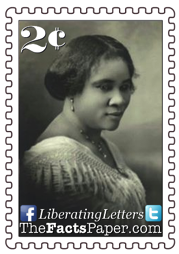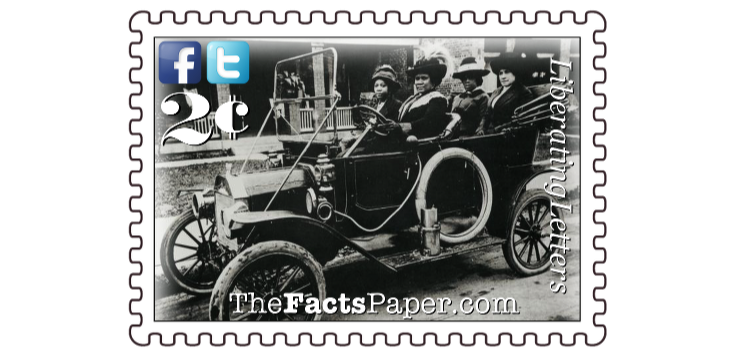May 25, 2017
Dear Liberty,
Standing at her washtub, Sarah readied to start the huge load in front of her. While bent over the washboard, she looked at her arms covered in soapsuds. She thought to herself, “What are you going to do when you grow old and your back gets stiff? Who is going to take care of your little girl?” It was at that moment, Sarah took complete control of her life.
Sarah was the youngest of Owen and Minerva Breedlove’s six children. Even though the whole family had been freed by Republican President Abraham Lincoln’s Emancipation Proclamation, she was the only one to obtain it from birth, being born December 23, 1867. (see Freedom Day) Even as free people, the family continued to work in the cotton fields near Delta, Louisiana.
Tragedy first struck the family when Minerva died in 1872. Owen soon remarried but he too died within a few years. Cared for by her siblings, 7-year-old Sarah and her older sister, Louvenia, found jobs as maids in Vicksburg, Mississippi, three years later. In 1882, to escape her abusive brother-in-law, Sarah married Moses McWilliams at age 14. She gave birth to her only child, Leila, on June 6, 1885, only to be widowed within two years.
Finding herself again alone, but this time with a child, Sarah needed to secure good, steady work to support herself and her daughter. With the Reconstruction Era ending and Democrats retaking state governments, Jim Crow laws were quickly becoming the norm, placing incredible obstacles in the way of blacks all throughout the South. (see From House Slave To House Of Representatives, Civil Rights...And Wrongs, Separate But Equal?, and The Birth Of A Nation) Her brothers, along with thousands of other blacks from the Mississippi River area, relocated in Kansas in 1879 in what is known as the Exoduster Movement. (see Is God Dead?) The brothers eventually settled in St. Louis, where they established themselves as barbers.
Sarah joined them in Missouri where she found work as a laundress and cook for $1.50 a day. She found hope, strength and important friendships at St. Paul African Methodist Episcopal (AME) Church. (see Hoosier Daddy) God guided her spiritual journey while her friends guided her earthly one. Many of the parishioners were members of the National Association of Colored Women and helped open Sarah’s eyes to the possibilities and opportunities in front of her. The success and refinement of those well-educated women did not embarrass or humiliate Sarah, nor did it hurt her feelings. Quite the contrary. It inspired her to pursue a better life for her and her daughter and dream of one day obtaining that same success and prosperity.
In 1894, Sarah married a second time to John Davis. Unfortunately, he was neither dependable nor faithful, with the marriage ending in divorce in 1903. To top off Sarah’s woes, she was beginning to lose her hair. Fortunately, she found Annie Turbo's “The Great Wonderful Hair Grower,” which not only started regrowing Sarah’s hair, it also became her career. Sarah acquired employment as a salesperson for Turbo where she soon met fellow salesman and journalist, Charles Joseph “C. J.” Walker, whom she began dating.
By 1905, Sarah was ready to branch out. She moved to Denver to establish her own clientele in the untapped area. C.J. soon followed and the two were married in 1906. To sound more legitimate and sophisticated, she changed her name to “Madam C.J. Walker,” adopting a french authenticity as opposed to the common “Auntie” derogative of the day.
One morning, Sarah awoke after having a dream that would change her life forever. According to Sarah, “A big black man appeared to me and told me what to mix up for my hair. Some of the remedy was grown in Africa, but I sent for it, put it on my scalp, and in a few weeks my hair was coming in faster than it had ever fallen out.” Using the African ingredient, she quickly designed her own hair products and began selling them under the name “Madam Walker’s Wonderful Hair Grower.”
But, as Sarah said in 1916, “Having a good article for the market is one thing. Putting it properly before the public is another.” She took to the streets to sell her hair care products, going door to door, visiting churches and lodges and advertising in black magazines and other publications. She also traveled across the south, talking to any potential customers she could find.
Sarah’s business quickly grew, allowing her to start hiring employees, the vast majority being black women. Wanting to give a hand up, and not a hand out, Sarah was “endeavoring to provide employment for hundreds of women of my race.” She opened Lelia College in Philadelphia in 1908 to train her “hair culturists,” but built a permanent factory and school in Indianapolis, which opened in 1910. By this time, Sarah’s daughter, who had changed her name to A’Lelia Walker, was working at her side, helping to run the business.
Even though Sarah and C. J. divorced in 1912, she continued to use Madam C.J. Walker, as it had become a household name. In 1913, she set her sights on Central America and the Caribbean, personally traveling there to promote her products. Back in the states, A’Lelia opened Walker Salon in Harlem, designed by the first licensed black architect in New York City, Vertner Tandy. In 1916, Sarah’s Indianapolis factor and school were stable enough that she decided to leave them in the hands of managers and move to New York with her daughter.
Madam C. J. Walker has been labeled as not only the first black female millionaire, but the first female millionaire in America. This accomplishment alone at the time is an amazing feat. However, not only did she improve her life, she sought to improve the lives of countless others.
As she stated in 1912, “Now my object in life is not simply to make money for myself or to spend it on myself in dressing or running around in any automobile, but I love to use a part of what I make to help others.” And that is exactly what she did. Not only did she help others by giving them prosperous jobs, she gave much of her money away to charities, orphanages, black organizations and educational institutions.
Sarah donated to causes such as the National Association of Colored Women, the YMCA, the YWCA, the Tuskegee Institute (see Like Father, Like Son and Proof Positive), and the NAACP (see A Tale Of Two Leaders), as well as many other schools and churches. She also contributed the largest donation to save Frederick Douglass’ Washington D.C. home. (see Reading, Writing And Redemption) She gave business lectures and political speeches as well as working with the government to persuade blacks to support World War I. Since Democrat President Woodrow Wilson was re-segregating the government and brought Jim Crow laws to a federal level, this did not sit well with many blacks. (see The Birth of A Nation) However, she understood the importance of an American win in the war. In addition, Sarah supported the Circle For Negro War Relief and pushed for training camps for black army officers. Her most prominent political cause involved getting KKK supporter Wilson to sign an anti-lynching bill, making the act a federal crime.
In 1917, Sarah again commissioned Tandy, this time to design her $250,000 home in Irvington-on-Hudson, near the homes of John D. Rockefeller and Jay Gould. After its completion, Villa Lewaro became a gathering place for local black leaders. More importantly, Sarah wanted the home to inspire other blacks to work for their dreams.
Liberty, if Sarah’s story doesn’t inspire you, than maybe her words will:
“I am a woman who came from the cotton fields of the South. From there I was promoted to the washtub. From there I was promoted to the cook kitchen. And from there I promoted myself into the business of manufacturing hair goods and preparations….I have built my own factory on my own ground.”
“I got my start by giving myself a start!”
“I want young people to see what can be accomplished by thrift, industry and intelligent investment of money.”
“Girls and women of our race must not be afraid to. . .wring success out of a number of business opportunities that lie at their very doors.”
“Don’t sit down and wait for the opportunities to come. You have to get up and make them for yourself!”
“There is no royal flower strewn path to success. And if there is, I have not found it, for whatever success I have attained has been the result of much hard work and many sleepless nights.”
Sarah died on May 25, 1919, of hypertension and kidney failure at just 51 years of age. However, she accomplished more than most would in several lifetimes. Her story is not just for women, or for blacks. It is a story of freedom and success for all Americans, nay all people.
Such freedom takes faith, faith in God and faith in yourself. Sarah had both. Liberty, I pray Sarah inspires you to take your future into your own hands. In those famous words of Doc Brown in Back To The Future III, “Your future is whatever you make it, so make it a good one.”
That’s my 2 cents.
Love,
Mom
SECRET OF HER SUCCESS




